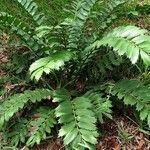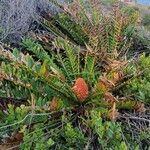A small cycad. It has an underground trunk. This can be 3 m long. It is 35 cm across. It is rarely branched but has new suckers near the base. The young leaves can be dark green or coppery brown and hairy. The mature leaves are in large numbers and form a rigid crown of obliquely erect leaves. These are stiff and 1-2 m long by 20-30 cm wide. The leaf stalk is 10-15 cm long. The lower leaflets are reduce to spine like processes. The cones are different. Male cones are 40-50 cm long by 7-10 cm wide. There are 1-10 on each stem. They have a fruit stalk 2-3 cm long. The female cone is 25-50 cm long by 20-25 cm wide. There are 1-5 on each stem. They do not have a fruit stalk. The seeds are 4.5-5 cm long by 1.5-2 cm wide. They are oblong and angular and red.
Leaves about 1 x 0–25 m.; median leaflets up to 20 x 7 cm., ovate with the margin fairly regularly divided into deltoid spinescent teeth which are c. 0–5 cm. long on the lateral margins but appear longer apically; leaflets diminishing in size towards the leaf-base, ultimately becoming bifurcated spines.
Female cone, 30 x 15 cm., 1–3, subsessile, bright red; median cone-scales up to 7 cm. long, glabrous, with a dorsiventrally flattened head of almost square outline bearing two long processes that extend to the cone-axis between the seeds of adjacent scales, the umbo concave terminally and not deflexed.
Seeds 5 x 1–5 cm., bright vermilion-red, becoming black, the fleshy part exceeding the stony inner part distally by about 2 cm.
Median male cone-scales ascending with the head deflexed; head triangular in outline with a hexagonal terminal facet.
Short-stemmed or with a trunk up to 1–3 m. tall.



